If you wish to contribute or participate in the discussions about articles you are invited to contact the Editor
Generic BCS Signals
| Fundamentals | |
|---|---|
| Title | Generic BCS Signals |
| Author(s) | J.A Ávila Rodríguez, University FAF Munich, Germany. |
| Level | Advanced |
| Year of Publication | 2011 |
In the previous lines we have studied two particular cases of the BCS modulation, namely the BPSK and BOC modulations. Nonetheless, the general expression derived at the beginning of the chapter is valid for any BCS vector. For exemplification, we show in the next lines how the PSD of a generic BCS could be derived.
Let us assume a BCS signal with vector s = [+1, +1, -1]. We have thus [math]\displaystyle{ s_1 = +1 , s_2 = +1 , s_3 = -1 }[/math]. The modulating term of the PSD can be easily calculated as:
which can be further simplified to:
while
Thus the spectrum of this BCS sequence would adopt the following form:
In general, in order to understand how the spectrum will look like for a given sequence, we have to be able to understand how every term of the sum above contributes to the total PSD.




